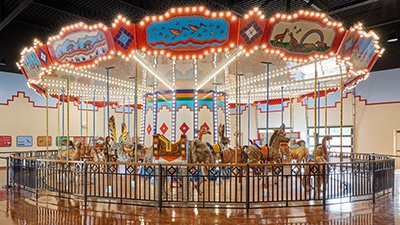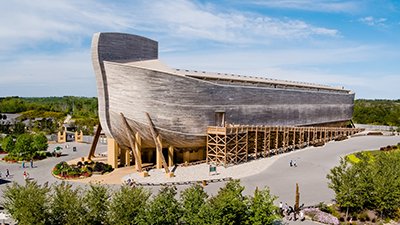
We’re Keeping the Rainbow at the Ark Encounter
During the Christmas season, we lit up the full-size Ark at our themed attraction, Ark Encounter, in rainbow lights for a beautiful display. Well, we’ve decided to enhance the rainbow lights and make them a permanent feature during evenings at the Ark, located south of Cincinnati. We will be working over the coming months to ensure this change is permanent. It’s all part of “taking the rainbow back.”
Now what do I mean by that? Well, in a blog post announcing the rainbow lights at the Ark, I wrote,
In recent times the rainbow (albeit with some different colors) has come to represent . . . freedom, love, pride, a new era, and, specifically, the LGBTQ movement. . . .
But the rainbow itself wasn’t designed to be a symbol of freedom, love, pride, or the LGBTQ movement. God created this beautiful, colorful phenomenon and designated it as a sign of His covenant with Noah and his descendants forever.
Sadly, people ignore what God intended the rainbow to represent and proudly wave rainbow-colored flags in defiance of God’s command and design for marriage. Because of this, many Christians shy away from using the rainbow colors. But the rainbow was a symbol of God’s promises before the LGBTQ movement—and will continue to be after that movement has ended. As Christians, we need to take the rainbow back and teach our young people its true meaning.
We’re trying to help Christians and unbelievers recognize the true meaning of the rainbow as it’s given to us in the Bible (Genesis 9).
History of the Rainbow
I’ve had people on social media claim that “the rainbow doesn’t belong to anyone.” Despite their insistence, they’re sure it’s not a symbol of God’s judgment and mercy and instead claim it symbolizes a spectrum of gender identities.
The rainbow colors were first used as a symbol of the gay community in the 1970s when San Francisco artist Gilbert Baker designed an eight-stripe flag.1 However, the use of bright colors to represent the gay community goes back a bit farther. People identified their homosexuality by wearing bright colors such as yellow, green, or purple. Baker took these bright colors and made them into a striped flag of pink, red, orange, yellow, green, blue, indigo, and purple. The pink was later dropped due to the unavailability of the fabric, and the indigo was left out to achieve an even number. That gave us the modern flag.
So the rainbow colors have been a symbol of the gay community since the 1970s. But the rainbow has been a symbol of the judgment and mercy of the Creator for much, much longer than that—around 4,300 years longer! You see, after the global Flood of Noah’s day, God made a promise to Noah, his family, their descendants, and the animals.
And God said: “This is the sign of the covenant which I make between Me and you, and every living creature that is with you, for perpetual generations: I set My rainbow in the cloud, and it shall be for the sign of the covenant between Me and the earth. It shall be, when I bring a cloud over the earth, that the rainbow shall be seen in the cloud; and I will remember My covenant which is between Me and you and every living creature of all flesh; the waters shall never again become a flood to destroy all flesh. The rainbow shall be in the cloud, and I will look on it to remember the everlasting covenant between God and every living creature of all flesh that is on the earth.” (Genesis 9:12–16)
The rainbow reminds us that God judged sin with a global Flood, but that He promises never to judge again with a global Flood—the final judgment will be by fire. Whether they realize it or not (and likely, in our secular age, they do not), gay activists and the gay community are using God’s symbol of judgment and salvation as a celebration of their sinful behavior. While God chose the rainbow in Genesis 9 to represent His longsuffering and patience, they are using that very symbol to proudly identify and celebrate their sin.
Gay Pride—Does It Bring Freedom and Peace?
Sadly, many think the celebration of their ungodly sexual lifestyle will give them freedom and peace. But it won’t. You see, those who refuse to submit to Christ are slaves to sin (Romans 6:16–21). You can’t be free or have peace when you are a slave! And believers who practice or celebrate homosexual behavior won’t have peace or freedom either because they are acting in disobedience to God’s commands, which brings about God’s discipline (Hebrews 12:5–11).
True freedom and peace are only found in Jesus Christ and obedience to His Word. It’s the power of the Holy Spirit that dwells in the believer that frees us from the bondage of slavery to sin (Galatians 5:16–26). Ironically, when flown on the gay flag, the colors of the rainbow represent bondage to sin, but the rainbow itself represents God’s mercy toward sinners. The real symbol represents freedom and the counterfeit symbol represents bondage!
Now, we aren’t displaying the rainbow colors or “taking the rainbow back” because we hate gay people, like some people have accused us of. We desperately want lost people—people made in the image of God and deceived by a lie—to hear the truth that God judges sin but that He lovingly offers a free gift of salvation to all who will believe. We want all people everywhere to experience the freedom and peace that comes through repenting of their sin and trusting in Christ.
The Rainbow in the Bible
Though Genesis 9 is the first place the rainbow appears in Scripture, it is not the only reference.
Like the appearance of a rainbow in a cloud on a rainy day, so was the appearance of the brightness all around [God on His throne]. This was the appearance of the likeness of the glory of the Lord. (Ezekiel 1:28)
Immediately I was in the Spirit; and behold, a throne set in heaven, and One sat on the throne. And He who sat there was like a jasper and a sardius stone in appearance; and there was a rainbow around the throne, in appearance like an emerald. (Revelation 4:2–3)
Both of these scenes depict the throne of God and glory of Christ. The rainbow not only symbolizes the mercy and judgment of God, but it also symbolizes God’s glory, beauty, holiness, and perfection. The beauty of the rainbow gives us a tiny glimpse of the glory and beauty of our Lord and Savior, Jesus Christ. Eventually this glorified Jesus will return, and on that day, to borrow the words of Dieudonne Tamfu, “The lofty pride of all men, including gay pride, will be brought low, and the Lord alone will be gloriously exalted.”2
A Coming Judgment
The rainbow reminds us that, in His mercy, God is withholding judgment from mankind. But He won’t do so forever. Second Peter 3:9–10 says,
The Lord is not slack concerning His promise, as some count slackness, but is longsuffering toward us, not willing that any should perish but that all should come to repentance. But the day of the Lord will come as a thief in the night, in which the heavens will pass away with a great noise, and the elements will melt with fervent heat; both the earth and the works that are in it will be burned up.
God is patiently withholding His judgment against sin because He isn’t willing that any should perish. But, eventually, a day is coming when He will judge all sin (not just sexual sin, but every sin), this time with fire. The rainbow should serve as a reminder of the reality of God’s past and coming judgment and also of His patience and mercy. Tamfu sums this up well:
Let us not be deceived. If God put a rainbow in the sky to symbolize the constraint of his anger, then he is still angry, and justly so because men are still sinners, as they were before the flood. One day, his anger will be restrained no more. The sky with its rainbows will be rolled up as a scroll, and our King Jesus will come from heaven in vengeance to defeat all of his enemies. And who are Christ’s enemies but those who oppose the gospel and live lawless lives, scorning their Maker? . . .
The next time you see a rainbow flag, think of this. One day soon, God’s glory, now seen dimly in the rainbow, will be fully revealed and draw everyone to worship. God’s glory will fill the earth. The glory of the LGBT movement will soon fade, but God’s glory and love toward those forgiven by faith in Jesus will last forever.3
Now many people accuse God of genocide or of being cruel by sending the Flood and, eventually, judging the world again. But God has every right to judge sin! We have sinned and rebelled against our Creator. It would be unjust of Him to allow sin to go unpunished, just as it would be unjust for a human judge to let a criminal off the hook. Sin deserves death—that’s the just punishment for our rebellion against our holy Creator (Genesis 2:17; Romans 5:12).
But the good news is that God is both just and merciful. We can’t save ourselves; our good works are like filthy rags to God in light of our sinfulness (Isaiah 64:6). So God sent His Son, the Lord Jesus, to die on the Cross, taking our sin—including the sin of homosexual behavior—upon Himself. But He didn’t stay dead. He rose from the grave, conquering death and sin, and He offers the free gift of forgiveness and eternal life to all who will believe (Romans 10:9). I urge you to repent and put your trust in Christ today, before it is too late.
You can learn more about the good news of the gospel .
Footnotes
- Forrest Wickman, “A Rainbow Marriage,” Slate, June 26, 2013, http://www.slate.com/articles/life/explainer/2012/06/rainbows_and_gay_pride_how_the_rainbow_became_a_symbol_of_the_glbt_movement_.html.
- Dieudonne Tamfu, “What Does the Rainbow Mean for Gays?,” Desiring God (blog), July 18, 2015, http://www.desiringgod.org/articles/what-does-the-rainbow-mean-for-gays.
- Ibid.
Recommended Resources

Answers in Genesis is an apologetics ministry, dedicated to helping Christians defend their faith and proclaim the good news of Jesus Christ.
- Customer Service 800.778.3390
- Available Monday–Friday | 9 AM–5 PM ET
- © 2025 Answers in Genesis





